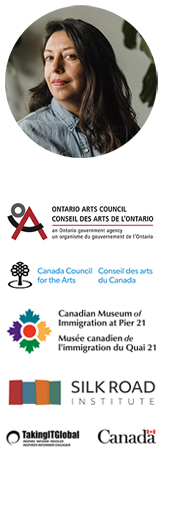Essay: Aquil Virani celebrates the stories of everyday people ––– by Devyani Saltzman
Click here to see the printed version of the essay in PDF format.
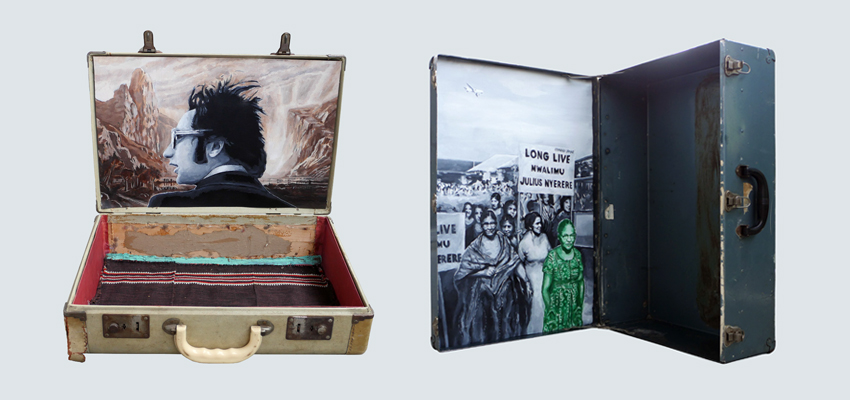
In Aquil Virani’s current work-in-progress, Unpacking Ismaili Baggage, 1972 (2022), a portrait of a man in a suit is painted amidst a western landscape on the inside cover of a vintage suitcase. The portrait is in black and white, the background in colour. The worn leather invokes nostalgia, longing and displacement. A second work in the series depicts women marching in Tanzania, also in black and white, a sole woman in kaftan, Virani’s paternal grandmother, in colour in the foreground, a plane at altitude in the distance. The series depicts the mass migration of Ismaili Muslims from East Africa, headlined by Idi Amin’s 1972 presidential decree that nationalized the property of “Ugandan Asians” and forced tens of thousands to flee to largely commonwealth countries, including Canada.
The series, commissioned on the 50thanniversary of the 1972 expulsion, touches on a number of themes that run through Virani’s work – documentary, portraiture and themes of belonging and displacement.
Virani, who was born in Canada and raised in Surrey, BC with an Ismaili father of Indian origin from Tanzania and a French mother, speaks of his work as “crafting narratives and doing things that documentary photography can’t do.”
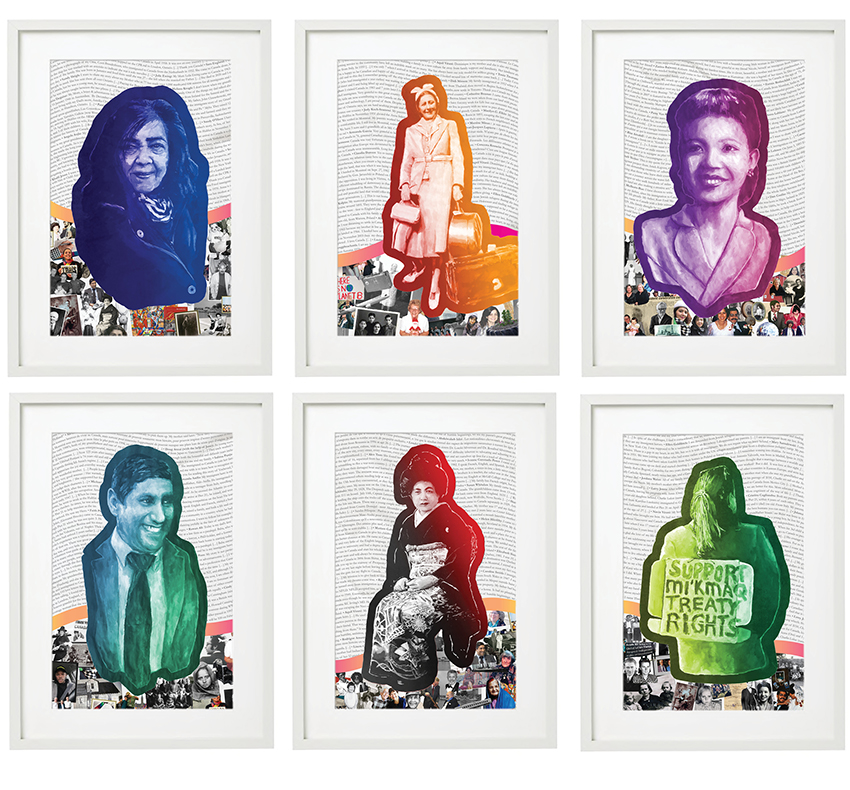
In another series, Our Immigrant Stories (2022), six works depict portraits of people from across the country now called Canada. Their images are painted in colour against a background of text telling their stories. The works sit alongside a nine-minute film and a book of one hundred additionally-submitted accounts.
Created while artist-in-residence at the Canadian Museum of Immigration at Pier 21 in Halifax, the series illustrates another key aspect to Virani’s practice, and possibly what is at the core of his work: the stories of everyday people, and their active participation in sharing their narratives.
The everyday voices of individuals shared through participatory portraiture is a unique and beautiful community-based practice. When asked “why portraiture?,” Virani responds that he is “drawn to human faces” and he believes “strongly in making work that is relevant and emotive for an audience. The best way to connect is through portraiture, because we are humans, drawn to other humans, putting people at the centre of our stories.”
Our Immigrant Stories highlights the large-scale collaborative art-making that is at the centre of Virani’s practice. Participants were invited to submit stories digitally and respond to the prompt “Who are the immigrant heroes in your life?” A daughter’s words about her mother, a nurse in Vancouver, are amplified via collage. A grandson reflects on the challenges of his grandmother’s arrival in Canada. Virani works in acrylic and spray paint – and more recently, short films, graphic design and installations. He cites growing up as the youngest child of a single mother after his parents divorced, time spent alone to draw, and the encouragement of a high school art teacher as foundational.
When asked how his upbringing as a mixed-race son of immigrants influences his work, Virani highlights it’s why he desires an art practice that involves people and uplifts a diversity of experience. It’s why he wants his art to contribute to social change movements. “Three pillars guide my evolving artistic practice:
accessibility and participation, social relevance, and representation.”
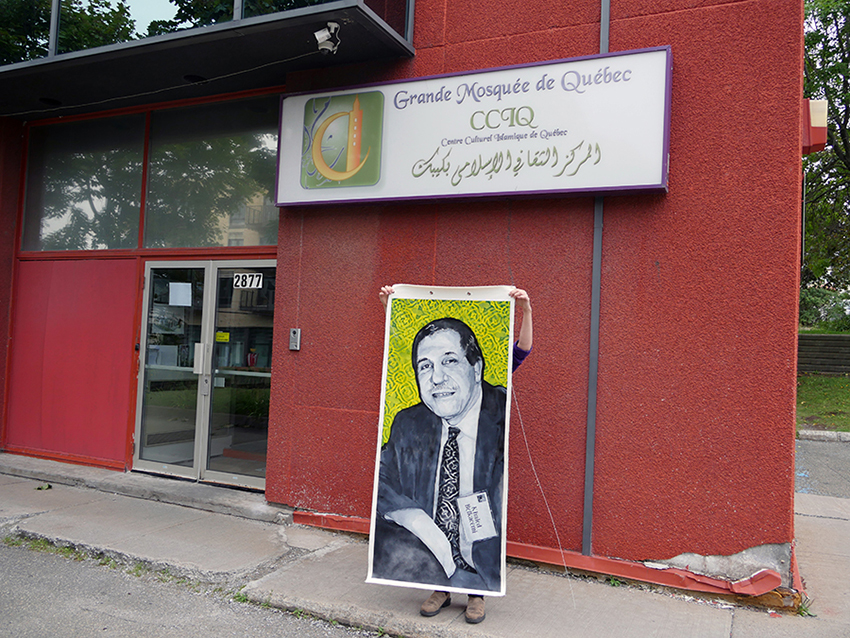
Maybe one of the most powerful examples of this is Les portraits commemoratifs en espace public (2019-21). The portraits are commemorations of the six men who were killed in the Quebec City mosque attack on January 29, 2017. Virani was invited to create the series by the widows, one of whom saw his work online and reached out to commission him. The resulting works are powerful large-scale portraits, which Virani then held in public space throughout the city and documented via photography before gifting them to the families. Alongside the portraits, he created 29 messages for Quebec, a limited-edition book, crowdsourced from the public all over the world and illustrated using stencils and black spray-paint.
Over many years, he has built a relationship with the Mosque and the families, but Virani notes that he is still very much an outsider in the Quebec City Muslim community, given the cultural and sectarian differences between them. When asked about how his own Muslim identity influences his work, he responds that he has a tough time answering that question. “Honestly, it’s hard because it’s impossible for me to separate what I gleaned from culture vs. religion. Ismailism is a religious community, but it’s also a cultural community. When I learn from my family, my aunts, my uncles, is that part of my religious education?”
What Virani’s body of work speaks to, in addition to participatory practice and portraiture, is a form of “subtle activism” rooted in seva, the ethic of selfless service, which is a tenant of Ismaili faith and practice. His projects are rooted in building empathy and inspiring change through listening to experience. “When I do participatory projects, I’m a facilitator, trying to stay true to the stories I’m entrusted with.” Along with this ethic comes necessary questions in relation to the nature of allyship.
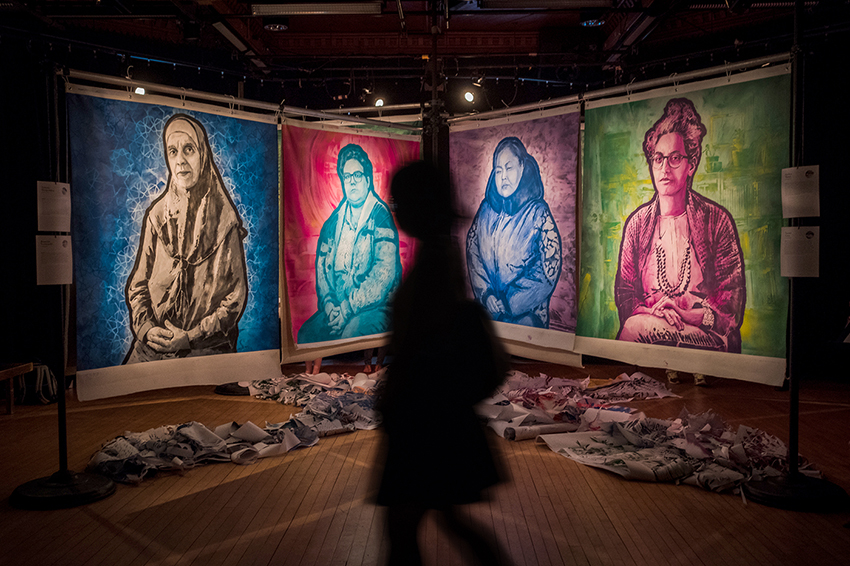
In CelebrateHer (2018), Virani painted twelve publicly-nominated women in a feminist portrait series and audiovisual installation, created in collaboration with Montreal’s Imago Theatre. It includes images of Indigenous leaders as portrayed by a settler artist. He’s deeply cognizant of representation and in our conversations asks himself, “Are you centering yourself? Or doing things the right way?” He notes that he is not an immigrant either and many of his projects involve newcomers. “I think about that a lot. How to act in solidarity.”
Alongside questions of solidarity, and collaborating to represent the stories of others, Virani reflects on pathways for newcomer artists, citing access issues to the art world, including lack of long-standing networks in Canada and art school as a common gateway (noting he himself did not go to art school). “All these issues are exacerbated if you are coming from afar. And in the public art world, museums, if you’re not yet immersed in a culture, you’re not yet immersed in the zeitgeist, and may not be hitting the ‘it’ topic that public spaces are interested in. Artists who face barriers are often pressured to make work about those barriers, about identity. Even in grant applications, I feel pressure to ‘Muslim it up.’”
Despite the challenges and expectations of the systems we operate within, Virani’s work is a rare collaborative commons where everyday stories are heard and shared, shaped by colour and form, and ultimately given back to community in the spirit of solidarity and seva. In a world increasingly divided, he continues to listen.
Devyani Saltzman (she/her) is a Canadian writer, curator, and arts leader with an in-depth practice in multidisciplinary programming at the intersection of the arts, ideas, and social justice. She was most recently Director of Public Programming at the Art Gallery of Ontario, one of North America’s leading art museums. Saltzman was previously the Director of Literary Arts at the Banff Centre for Arts and Creativity, as well as a founding Curator at Luminato, Toronto’s international multidisciplinary arts festival. She is the author of Shooting Water which The New York Times called “a poignant memoir.” Her work has appeared in The Globe and Mail, The Atlantic, Room Magazine, and Tehelka, India’s weekly for arts and investigative journalism. Saltzman has a Masters in Anthropology and Sociology and is currently working on her second book of nonfiction. @DevyaniSaltzman
Acknowledgements: The production of this essay was supported by a grant from the Ontario Arts Council; it contains artworks that were produced with funding from the Canada Council for the Arts, the Ontario Arts Council, the Canadian Museum of Immigration at Pier 21, the Silk Road Institute, Imago Theatre, TakingItGlobal and the Government of Canada.

